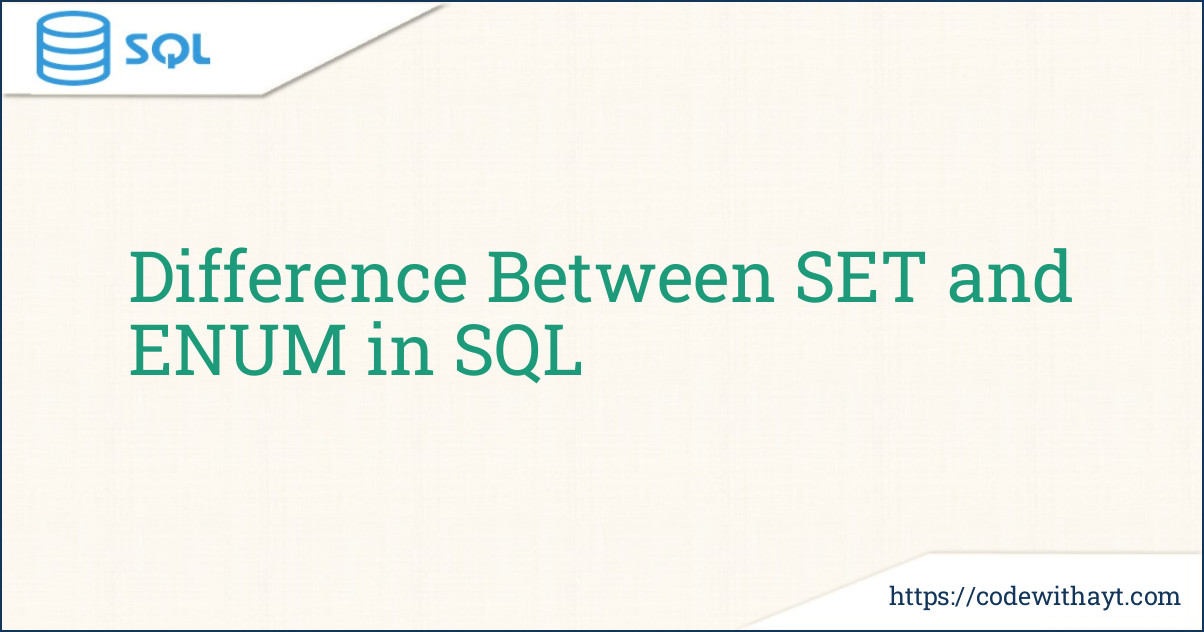When designing a database in SQL, choosing the right data type for your columns is crucial. Two commonly misunderstood data types are SET and ENUM. While they both deal with predefined values, they work quite differently. In this blog, we’ll break down their differences in simple terms with examples.
What is ENUM in SQL?
ENUM (short for enumeration) is a data type that allows you to store a single value from a predefined list of values. Think of it like a dropdown menu where you can only select one option.
Example: Using ENUM for Gender
CREATE TABLE users (
id INT AUTO_INCREMENT PRIMARY KEY,
name VARCHAR(50),
gender ENUM('Male', 'Female', 'Other')
);
Here, the gender column can only have one of the three values: 'Male', 'Female', or 'Other'. If you try inserting a different value, SQL will throw an error.
Key Points About ENUM:
-
Can store only one value from the predefined list.
-
Saves space by storing values internally as numbers (e.g.,
'Male'= 1,'Female'= 2). -
Fast and efficient when used for limited options.
What is SET in SQL?
SET is similar to ENUM, but with a major difference—it allows multiple values from the predefined list. Think of it like checkboxes where you can select more than one option.
Example: Using SET for User Interests
CREATE TABLE users (
id INT AUTO_INCREMENT PRIMARY KEY,
name VARCHAR(50),
interests SET('Music', 'Sports', 'Reading', 'Traveling')
);
With this setup, a user can have multiple interests. For example, you can insert:
INSERT INTO users (name, interests) VALUES ('Rohit', 'Music,Sports');
This means Rohit is interested in both Music and Sports.
Key Points About SET:
-
Can store multiple values from the predefined list.
-
Values are stored as bitwise numbers internally, making queries efficient.
-
Useful when you need multiple selections (like tags, preferences, etc.).
Key Differences Between SET and ENUM
| Feature | ENUM | SET |
| Selection | Only one value from the list | Multiple values from the list |
| Storage | Stored as small integer values | Stored as bitwise numbers |
| Use Case | Ideal for single-choice fields (e.g., status, gender) | Ideal for multiple-choice fields (e.g., interests, tags) |
| Performance | Faster for single-value comparisons | Efficient for multi-value storage but can be tricky for searches |
When to Use ENUM vs. SET
-
Use
ENUMwhen you have fixed categories where only one value is allowed (e.g.,'Active','Inactive','Pending'). -
Use
SETwhen you need multiple selections from a fixed list (e.g., a list of hobbies, roles, or permissions).
Conclusion
Both ENUM and SET are useful in different scenarios. ENUM is best for situations where you need to store only one value from a predefined list, while SET is perfect when multiple values need to be stored efficiently. However, keep in mind that using them excessively can lead to database design limitations, so use them wisely!



